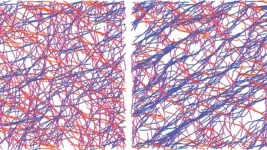(Press-News.org) For many of us, our smartphone has become our ever-present companion and is usually far more than just a phone. Thanks to the constant availability of online content as well as our reachability through messenger services and social networks via our smartphone, this everyday object's potential to distract us is high - at work too. This is why many employers view the use of smartphones during work time with suspicion, and countermeasures taken range from asking staff to refrain voluntarily from using them to banning smartphones in the workplace through an internal agreement. But do such measures actually work and, if so, how?
This is the question now being examined by an interdisciplinary team of economists and a social scientist from the universities of Konstanz, Lüneburg and Vechta in the framework of a comprehensive field experiment and accompanying surveys on the topic. The study, which has been published in the journal Experimental Economics, shows that the benefits of smartphone bans in the workplace depend on the type of work: In the case of standard routine tasks, there was a measurable increase in efficiency as a result of "soft" smartphone bans, that is, bans that are not sanctioned if they are disregarded. By contrast, they did not notably improve the execution of more complex tasks. As possible success factors for soft bans, the study identified that they can change people's perception of social norms, that freedom of choice remains with staff and that these show understanding for the measures.
Corporate managements disagree on effectiveness
Many companies find the distraction of staff through the use of private smartphones in the workplace problematic. However, since smartphones are private property, a strict ban on their use is difficult to enforce and can hardly be controlled, especially in times where people are working more and more from home. That is why the measures taken by companies frequently do not go beyond so-called "soft", non-monitored bans - if any at all - the disregard of which has no consequences. An example of a soft ban would be a written appeal to staff not to use their smartphone during work time. However, there is much disagreement among employers about the effectiveness of such soft bans.
"A survey we conducted in collaboration with the Chamber of Commerce and Industry of Berlin showed that about 20 percent of the companies interviewed already work with soft smartphone bans," reports Dr Adrian Chadi, junior professor for personnel economics and human resource management at the University of Konstanz and one of the authors of the current study. In turn, about half of these 20 percent considered the measures to be successful, but the other half doubted that workforce performance is positively influenced by soft smartphone bans.
Telephone study as field experiment
To gain more clarity in this regard, the researchers carried out a large-scale field experiment: Over 100 students were assigned the task of phoning lists of telephone numbers as part of a real side job and conducting interviews with volunteers for a university research project independent of this study. In this context, a soft ban was imposed on some of the students on using their smartphones during work time, while for the others the private use of smartphones was not expressly forbidden.
A comparison of the two groups' performance showed that the students banned from using their private smartphones made about ten percent more calls per hour than the students without a ban. However, the ban did not have a clear effect on the number of successfully completed interviews, which suggests that the success of a smartphone ban in the workplace depends on the specific type of work. "In the case of less demanding routine tasks, such as working through a long list of phone numbers, it's helpful not to be distracted by a private smartphone. With more complex, creative tasks, such as convincing strangers to participate in a survey, on the other hand, occasional use of a private smartphone between calls seems to be less detrimental," says Chadi, going into more detail.
The secrets of success of "soft" bans
In the framework of further surveys, the researchers looked deeper into the reasons for the effectiveness of soft smartphone bans. One consideration here was that they might change employees' perceptions as to what is socially appropriate. "Social norms play an important role in the context of bans. Soft bans could lead to staff themselves seeing it as less appropriate to use their smartphones during work time - due to perceived social pressure," explains Chadi. "This means that companies might hope to increase productivity in the workforce with soft bans - and without penalties and monitoring leading to distrust, rejection or a negative impact on productivity as a result of declining motivation."
Indeed, the evaluation of follow-up interviews with the students involved in the field experiment revealed that the group with a soft ban on the use of smartphones used them far less frequently during work time than the group without a smartphone ban, indicating that they respected the ban voluntarily. This can explain the difference in productivity described. At the same time, job satisfaction in both groups was very high. "This probably means that it's precisely the voluntary nature of observing rules which is one of the secrets of success of soft bans," assumes Chadi.
Understanding as a further factor
As a further factor for the success of the soft smartphone ban in the study, the follow-up interviews identified that staff could understand their employer's concern and that the ban therefore also made sense from their point of view. Here, the researchers can even see a transferability of their results to other contexts. "The perceived meaningfulness of a ban as well as retaining the right to make autonomous decisions about your own behaviour are with great probability determining success factors not only in the workplace context and are therefore more expedient than enforcing bans by means of coercion and surveillance," says Chadi.
INFORMATION:
Key facts:
Original publication: Adrian Chadi, Mario Mechtel, Vanessa Mertins (2021). "Smartphone bans and workplace performance", Experimental Economics; DOI: 10.1007/s10683-021-09715-w
The benefits of "soft" smartphone bans in the workplace depend on the type of work and are particularly evident in the case of routine tasks.
Possible favourable factors for the effectiveness of soft bans are people's changed perception of social norms as a result of the respective ban as well as the fact that staff retain freedom of choice and show understanding for the measure.
The original publication is freely available as an open access article. Licensing was undertaken in accordance with the Project DEAL Contract with Springer Nature.
Contact:
University of Konstanz
Communications and Marketing
Phone: + 49 7531 88-3603
Email: kum@uni-konstanz.de
- uni.kn/en
DURHAM, N.C. - Special diets, exercise programs, supplements and vitamins -- everywhere we look there is something supposed to help us live longer. Maybe those work: human average life expectancy has gone from a meager 40-ish years to a whopping 70-something since 1850. Does this mean we are slowing down death?
A new study comparing data from nine human populations and 30 populations of non-human primates says that we are probably not cheating the reaper. The researchers say the increase in human life expectancy is more likely the statistical outcome of improved survival for children and young adults, not slowing the aging clock.
"Populations get older mostly because more individuals get through those early stages of life," ...
In the majority of insects, metamorphosis fosters completely different looking larval and adult stages. For example, adult butterflies are completely different from their larval counterparts, termed caterpillars. This "decoupling" of life stages is thought to allow for adaptation to different environments. Researchers of the University of Bonn now falsified this text book knowledge of evolutionary theory for stoneflies. They found that the ecology of the larvae largely determines the morphology of the adults by investigating 219 earwig and stonefly species at high-resolution particle accelerators. The study has ...
Osteoporosis researchers at the UVA School of Medicine have taken a new approach to understanding how our genes determine the strength of our bones, allowing them to identify several genes not previously known to influence bone density and, ultimately, our risk of fracture.
The work offers important insights into osteoporosis, a condition that affects 10 million Americans, and it provides scientists potential new targets in their battle against the brittle-bone disease.
Importantly, the approach uses a newly created population of laboratory mice that allows researchers to identify relevant genes and overcome limitations of human studies. Identifying such genes has been very difficult but is key to using genetic discoveries to improve ...
Woods Hole, MA (June 16, 2021) -- Woods Hole Oceanographic Institution (WHOI) climate modeler Dr. Alan Condron and United States Geological Survey (USGS) research geologist Dr. Jenna Hill have found evidence that massive icebergs from roughly 31,000 years ago drifted more than 5000km (> 3,000 miles) along the eastern United States coast from Northeast Canada all the way to southern Florida. These findings were published today in Nature Communications.
Using high resolution seafloor mapping, radiocarbon dating and a new iceberg model, the team analyzed about 700 iceberg scours ("plow marks" on the seafloor left behind by the bottom parts of icebergs dragging through marine sediment ) from Cape Hatteras, North Carolina to the Florida Keys. ...
Researchers from the Max-Planck Institute for Terrestrial Microbiology have discovered a surprising asymmetry in the mating behavior of unicellular yeast that emerges solely from molecular differences in pheromone signaling. Their results, published in the current issue of "Science Advances", might shed new light on the evolutionary origins of sexual dimorphism in higher eukaryotes.
Resemblant of higher organisms, yeast gametes communicate during the mating process by secreting and sensing sexual pheromones. However, in contrast to higher eukaryotes, budding yeast is isogamous: seen through a microscope, gametes of both mating types ("sexes"), MATa and MATα, look exactly the same. Since anisogamy -- difference in size between male and female gametes --was ...
HOUSTON ? The University of Texas MD Anderson Cancer Center's Research Highlights provides a glimpse into recently published studies in basic, translational and clinical cancer research from MD Anderson experts. Current advances include a new combination therapy for acute myeloid leukemia (AML), a greater understanding of persistent conditions after AML remission, the discovery of a universal biomarker for exosomes, the identification of a tumor suppressor gene in hepatocellular carcinoma (HCC) and characterization of a new target to treat Clostridioides difficile (C. difficile) infections.
Utilizing combination therapy for AML
While a majority of patients with acute myeloid leukemia (AML) respond favorably ...
Scientists at Weill Cornell Medicine have developed a computational technique that greatly increases the resolution of atomic force microscopy, a specialized type of microscope that "feels" the atoms at a surface. The method reveals atomic-level details on proteins and other biological structures under normal physiological conditions, opening a new window on cell biology, virology and other microscopic processes.
In a study, published June 16 in Nature, the investigators describe the new technique, which is based on a strategy used to improve resolution in light microscopy.
To study proteins and other biomolecules at high resolution, investigators have long relied on two techniques: X-ray crystallography ...
A new rubber band stretches, but then snaps back into its original shape and size. Stretched again, it does the same. But what if the rubber band was made of a material that remembered how it had been stretched? Just as our bones strengthen in response to impact, medical implants or prosthetics composed of such a material could adjust to environmental pressures such as those encountered in strenuous exercise.
A research team at the University of Chicago is now exploring the properties of a material found in cells which allows cells to remember and respond to environmental pressure. In a paper published on May 14, 2021 in Soft Matter, they teased ...
PHILADELPHIA - Amyotrophic lateral sclerosis (ALS), also known as Lou Gehrig's disease, is a neurodegenerative disease that strikes nearly 5,000 people in the U.S. every year. About 10% of ALS cases are inherited or familial, often caused by an error in the C9orf72 gene. Compared to sporadic or non-familial ALS, C90rf72 patients are considered to have a more aggressive disease course. Evidence points to the immune system in disease progression in C90rf72 patients, but we know little of what players are involved. New research from the Jefferson Weinberg ALS Center identified an increased ...
While crop yield has achieved a substantial boost from nanotechnology in recent years, alarms over the health risks posed by nanoparticles within fresh produce and grains have also increased. In particular, nanoparticles entering the soil through irrigation, fertilizers and other sources have raised concerns about whether plants absorb these minute particles enough to cause toxicity.
In a new study published online in the journal END ...






